Cycling Nutrition: Illustrated Guide to Eating and Drinking on the Bike
Good eating and hydration practices on the bike are some of the simplest ways to get more out of your training rides and event performances
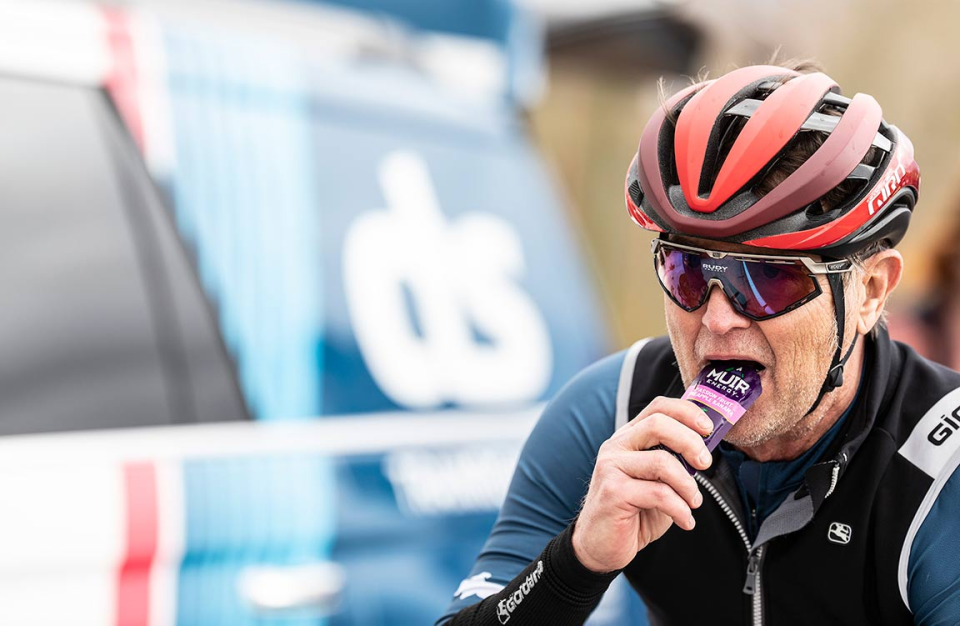
This topic has been covered on this blog before (like in this article: Nutrition for Rides of any Length), but we have a lot of newer readers and plenty of long-time readers who could use a refresher. Even if you’re relatively familiar with the numbers not always so straight-forward to put all the guidelines into practice because no one wants to pull out a calculator every time they plan what to eat on a ride! So, in this article I’ve included more pictures to make it easier to visualize.
Why do we need to eat and drink on longer rides?
The simple answer to why we need to eat and drink for longer rides is to maintain our effort level and increase chances of having a good performance. Can you ride with less fuel? Sure, just slower and at lower power outputs. During your rides you’re primarily burning through stored energy, a combination of fat and carbohydrates (in the form of muscle glycogen), and we’re also losing body fluid in the form of sweat. It’s important to replace both fluids and carbohydrates, especially as factors like temperature, sweat rate, intensity level, and duration affect how quickly you run low on fluids and carbohydrate energy.
Hydration Recommendations
An individual’s fluid needs may change depending on temperature and sweat rate, but a good place to starts is to drink 20-30 ounces of fluid every hour. That is a little over half a liter to a liter per hour for our friends in Canada and Europe, or simply the volume of 1-1.5 standard water bottles. A standard bottle is typically 20 ounces, and large bottles are around 24 ounces. So, you can stick with the 1-1.5 bottles rule when using the larger ones too. In hot conditions when sweat rates are high, fluid needs can go upwards of 40 ounces or 2 bottles per hour.
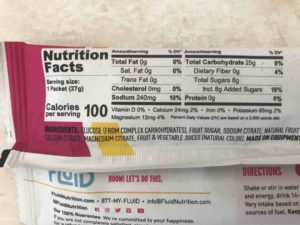 Replacing fluids should come from both plain water and sports drink. The main purpose behind drinking sports drink instead only water is to replace sodium. A person’s sodium needs will vary depending on sweat rate and temperature, but a good base recommendation is to consume 250-500 mg sodium per hour between food and sports drinks.
Replacing fluids should come from both plain water and sports drink. The main purpose behind drinking sports drink instead only water is to replace sodium. A person’s sodium needs will vary depending on sweat rate and temperature, but a good base recommendation is to consume 250-500 mg sodium per hour between food and sports drinks.
Many popular sports drinks will deliver 250-350 mg of sodium per typical serving. I say “typical serving” because many powdered mix servings are for 12-16 ounces of water. Most people will just dump that one scoop from the bag or one serving from a single-serve pack in to one 20-oz bottle. I’ve never seen anyone use one and a quarter single serve packets of drink mix to precisely measure for a standard size bottle.
Most sports drinks also contain carbohydrates (simple sugars) in the range of 20-30 grams per bottle which works out to 80-120 calories per 20-oz bottle. CTS Coaches use Fluid Performance sports drink and provide it to athletes during CTS Camps. Whichever sports drink you choose, you want to consider the calories from your hydration when you’re planning your food intake because it’s easy to over-consume calories if you don’t. This can cause GI distress from having too much sugar in the gut at once, and why it’s good to have plain water in addition to sports drink on your rides. Whenever you eat food or take a gel, you should drink a few big gulps of plain water with it. That will help dilute the calories you’re consuming and speed gastric emptying and avoid GI distress. This will also help maintain hydration status because too high a concentration of sugar in the gut pulls water out of your cells to lower the osmolality of the solution in your gut so it can then be absorbed into the body. This slows down the delivery of energy to working muscles, particularly if you are already slightly dehydrated or overheated.
Another option for sports drinks are electrolyte tabs that contain only electrolytes (mainly sodium) and very few calories. An advantage to using these kinds of tablets is that you can increase fluid intake in response to heat, increased sweat rate, or increased intensity without overloading your gut with more calories than it can handle.
Not the best choices
It’s not the purpose of this article to do a deep dive into comparing all drinks, but it may be helpful of knowing some choices to avoid.
- Sports drinks that are too sweet (too much sugar). Gatorade is the original sports drink, but it’s also on the upper limit of sugar content (>6% concentration), and many people find it too sweet. If you dilute it, that dilutes the sodium content. Of all the Gatorades, G2 is a little better choice. It has 50 calories per 20 ounces bottle as opposed to regular Gatorade that is 140 calories.
- Coke, other sodas, and energy drinks are even higher concentration of sugar (240 calories for a 20-ounce Coke), but I bet you’ve seen the pros taking a Coke in races. They’re drinking that for the sugar boost and little bit of caffeine. Treat a soda or energy drink more like taking a gel than for hydration. If you consume a high-calorie drink like a Coke, make sure you’re drinking water with it as you do with other foods or gels.
- Drinks without enough sodium. Coconut water and many of the vitamin waters are low in sodium. They’re not bad, per se, but it’s better to think of them as flavored water rather than functional sports drinks.
Nutrition Recommendations
The most important considerations for your fueling strategy are exercise duration and intensity. The longer the ride, the more important fueling strategy becomes because you start running low on stored carbohydrates (muscle glycogen). Carbohydrates are the primary fuel for moderate to high intensity exercise, and unlike the virtually unlimited energy we have in fat stores, we can only store about 400-500 grams of glycogen (1600-2000 calories), which can be depleted in 60-90 minutes of intense exercise or 2-3 hours at a moderate pace. That’s why we put so much emphasis on carbohydrate replacement during rides.
Recommendations on fueling say that you generally don’t need to consume any calories on rides under 60-75 minutes, and you should be fine with plain water. However, some people do better when using an electrolyte-rich sports drink. Carbohydrate + Electrolyte drinks might be beneficial for those early morning workouts when you’ve only had a light snack before training and can benefit from consuming a little bit of sugar. I also find some athletes drink more when they have sports drink instead of plain water. If taking sports drink means you stay better hydrated on short rides that’s as good a reason as any to use it.
On rides of 75 minutes to 2.5 hours you can fuel mostly with simple carbohydrates like sports drinks, gels, and gummy chews. (CTS Coaches use ProBar Bolts and Muir Energy gels) Ideally, keep the calories coming in small (100-150 calories), frequent doses (every 20-30 minutes) rather than eating a lot all at once. How much you consume is based mainly on your size and energy expenditure. The recommended range of calories per hour is 150-300, and it’s so wide to accommodate a wide range of needs. Larger people burn energy at a higher rate than smaller people, and intensity counts too. Higher intensity means higher hourly energy expenditure.
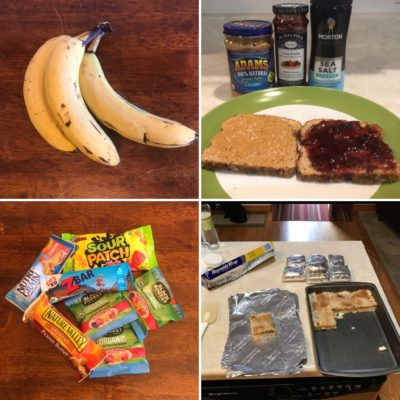
REAL FOODS ARE THINGS LIKE BANANAS, PB&J, CEREAL BARS, KIDS FRUIT SNACKS, GUMMY WORMS, AND RICE CAKES. THESE AREN’T ENGINEERED SPORTS NUTRITION PRODUCTS, BUT CERTAINLY FIT THE BILL WHEN IT COMES TO PROVIDING GOOD, QUICK ENERGY ON YOUR RIDES. LOOK FOR ITEMS THAT ARE HIGH IN CARBOHYDRATE, LOW IN FAT, AND LOW IN PROTEIN.
On rides over 3 hours, you would typically include more complex nutrition items. Complex nutrition foods are things items with a little bit of fat or protein in addition to just carbohydrates. That would be something like your typical energy bar or a peanut butter and jelly sandwich. You still want to keep carbohydrates as your primary source of energy, at the level of 30-60 grams per hour (up to 90 grams per hour), but a little bit of fat or little bit of protein in your food is generally is well tolerated in the gut during longer rides because intensity is often lower. These also can provide a little more sustainable energy as you are riding through mealtimes on those epic days. Just don’t wait too long into your rides to eat. Start fueling in the first 45 minutes and keep it coming in with 100-150 calories every 20-30 minutes, so you avoid lulls in energy and GI distress from eating too much at once.
I find there’s variation in fueling strategies in mid-length rides of 2-3 hours where needs and preferences often depend on intensity of the ride. Most of the time on rides of this length, it is sufficient to stick to the high-carbohydrate, easy to digest sources like gummies, gels, and sports drink. That works well for high-intensity interval sessions and group rides. However, on easier Zone 2 or Foundation Mile rides a bar with some protein and fat can be a good option because the intensity is lower, and it’s a lot easier to chew and swallow a bar when you’re not breathing out of your ears from the effort.
Choosing the Right Energy Bar
Go to the grocery store and you’ll see an entire isle for fitness food/ sports nutrition food, and it can be tough to know which ones are best. A good bar choice is high in carbohydrate, lower in fat, and lower in protein. A high-carbohydrate bar will have at least double the grams of carbohydrate than either grams of fat or protein. I’ve shown a few good examples below, including the ProBar Bites we provide during CTS Camps. Each of these has at least 20-40 grams of carbohydrate, less than 10 grams of fat, and less than 10 grams of protein.
Bars that are labeled as protein bars aren’t the best choice during rides. As the category name suggests, they are high in protein and often lower in carbohydrate. Save the higher protein bars for post-ride recovery and snacking. Many of the nut-based bars and candy bars tend to be high in fat. With the higher fat content these bars can sit heavier in your stomach because they are slower to digest. This doesn’t mean that you’d never eat one of these types of bars on a ride. I’ve seen plenty of great athletes eat their fair share of Snickers bars on long rides, but they aren’t necessarily your ideal go-to everyday on-the-bike energy bar.
Putting it Together for Fueling and Hydration
Rides under 75 minutes
1 bottle plain water/ and or 1 bottle sports drink (100 calories – 25g carbohydrates)
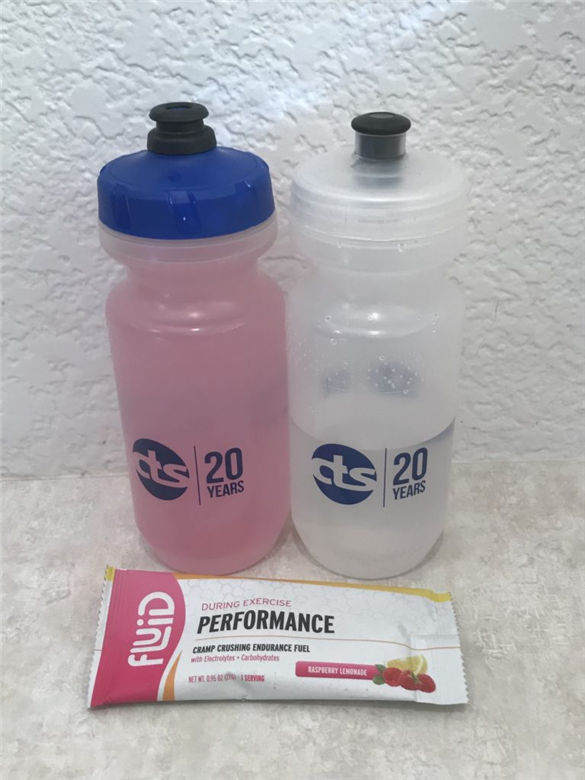
Rides 75 minutes to 2 hours.
Examples of what you could consume per hours to reach 200-300 calories with 20-30 ounces of fluid and at least 300 mg sodium.
- Bottle Fluid Performance, ½ bottle plain water, 1 Muir energy gel (200 calories – 46 g carb)
- Bottle Fluid Performance, ½ bottle plain water, half to full bag of Probar Bolts (190-280 calories – 49-73 g carb)
- Bottle Fluid Performance, ½ bottle plain water, 1 Probar Bite (240 calories – 47g carb)
- Bottle Fluid Performance, ½ bottle plain water, 2 Muir energy gel (300 calories – 67 g carb)
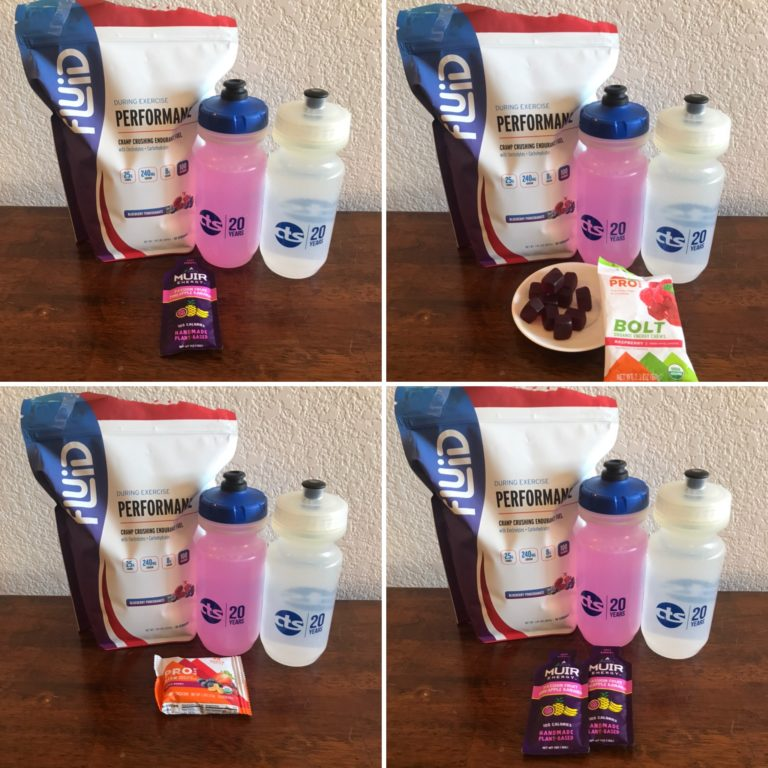
Rides 3+ hours
Examples of what you could eat per hour that total 250-350 calories with 20-30 ounces and 300-500mg sodium.
- 1 bottle Fluid Performance, ½ bottle water, ½ pb&j (240 calories – 47g carb)
- 1 bottle Fluid Performance, ½ bottle water, 1 Probar Bite, 1 Muir Energy gel (340 calories – 68g carb)
- 1 bottle Fluid Performance, ½ bottle water, 1 Probar Bite, ½ bag Probar Bolts (5 chews) (330 calories – 70g carb)
- 1 bottle Fluid Performance, ½ bottle water, 1 and a half Probar Bite (310 calories – 58g carb)

Summary
The guidelines below summarize best practices for nutrition and hydration in training and events.
Hydration:
- 20-30 ounces fluid per hour (1-1.5 bottles per hour).
- Sports Drink: 250-350 mg sodium and up to 130 calories/ 30 g carb per bottle (6% concentration).
- Water: Drink few gulps of water every time you eat food/ gel.
Nutrition on rides over 75 minutes:
- Calories: 150-300 (up to 350) per hour combined drink and foods.
- Carbohydrates: 30-60 grams carbohydrates up to 90 g/hr.
- Protein: minimal on shorter rides and foods with less than 10 grams on longer rides.
- Fat: minimal on shorter rides and foods with less than 10 grams on longer rides.
Putting good nutrition and hydration into practice should help you have better and more consistent performances in your training sessions and event rides. The goal is to help preserve your ability to maintain a high effort, but remember that food won’t completely overcome fatigue. It is possible to have too much of a good thing, especially on the calorie side. Too many calories can cause GI distress and slow you down because your body needs extra energy to process a lot of calories at once. So, for best results stick to those hourly guidelines with consistent small doses. If you’re fading at the end of your ride, you might just be tired!
I gave a lot of suggestions with a variety of hydration products, sports nutrition foods, and real foods, but certainly didn’t cover all combinations. Trying a variety of foods in training will allow you to figure out your preferences and can help you develop flexibility in your nutrition plan. Also, sometimes in event rides you might be subject to whatever food and drink is available and being flexible will help you be successful. Remember, these are just guidelines, and what’s most important is what works for you on an individual basis.
To find out more, please visit: https://trainright.com/cycling-nutrition-guide-eating-drinking-on-bike/
